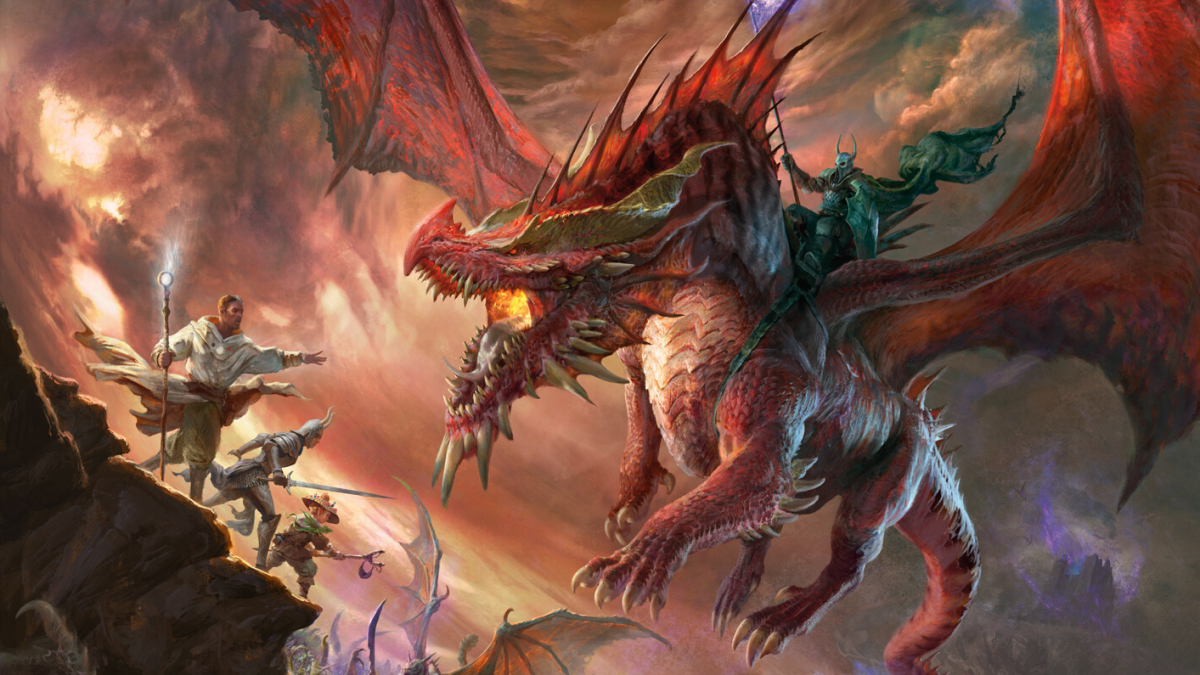What You Need to Know About Dungeons & Dragons: Dragonlance
One of the most beloved Dungeons & Dragons campaign settings has returned! Here's everything you need to know about Dragonlance: Shadow of the Dragon Queen.

This article is presented by 
Dragonlance: Shadow of the Dragon Queen is coming, and the buzz from long-time Dungeons & Dragons fans is completely understandable. Dragonlance was once a prominent campaign setting (as well as the home for a library of fiction adventures) in almost every edition of D&D (it was skipped in 4E). A return to Dragonlance after that hiatus is something longtime players have been eagerly anticipating. But if you’re new to D&D or shared-world fantasy, what do you need to know to share that excitement? We’re taking a peek behind the curtain at the history of Dragonlance, highlighting some of the world’s best, most unique features to get you ready to join the War of the Lance.
Real World History
As a game setting, Dragonlance was designed to focus more on a themed saga than an open world, the way previous campaign settings had. Adventures would feature events put into motion by gods and dragons, in which player characters became embroiled. The first saga became the War of the Lance, in which players (and the novel characters) face off against the dragon armies of the evil goddess Takhisis (the eponymous Dragon Queen), who is trying to return to the world of Krynn; she uses her minions on Krynn, in the form of both dragons and mortals, to free her from her divine prison. Shadow of the Dragon Queen returns to this era, letting players reinvent the path forward for Krynn.
The Dragonlance setting was first introduced in 1984. Created by Tracy Hickman and his wife, Laura, and enhanced with editor and co-writer Margaret Weis, Dragonlance became a bestselling world for both fiction and adventures. The first module (a published adventure or series of adventures for a Dungeon Master to lead players through) brought players and readers in at the beginning of the War of the Lance.
Early adventures were released for Advanced Dungeons and Dragons, with a full world sourcebook released for both AD&D and Dungeons & Dragons 2nd Edition. After a sojourn into TSR’s diceless SAGA system, a 3rd edition campaign setting came out through Margaret Weis’s own game publishing company, Sovereign Press, in 2003. But no new sourcebooks or adventures have been released since 2007, with only a short PDF preview, Heroes of Krynn, released for 5E—until Dragonlance: Shadow of the Dragon Queen. The 5E campaign and sourcebook has tips for being used alongside a large Dragonlance board game as well, encouraging (but not requiring) gamers to enhance their experience with Dragonlance: Warriors of Krynn.
The War of the Lance
Shadow of the Dragon Queen launches players into the same timeline as the characters of the original novels, when powerful, evil dragons and the evil goddess Takhisis are planning to conquer the entire continent of Ansalon. In the books, the company standing between the dragons and the people of Ansalon becomes known as the Heroes of the Lance. While those original characters provide inspiration for future adventurers, Shadow of the Dragon Queen is a chance for players to take the lead on saving the world.
The campaign opens with three hooks that allow players to delve into the game from different angles. For those interested in exploring the connection between Krynn and her lost gods, Shadow of the Dragon Queen offers players a chance to connect with the absent deities, if they want their characters to begin with a divine calling. Others can start among the Mages of High Sorcery, while those with less magical inclinations may be more interested in a combat entry into the War of the Lance, and the adventure path accounts for that, too. Villains like Takhisis and the terrifying Lord Soth, an undead evil paladin who rides a death dragon, also find their best scenes in the novels—inspiring how future gamers could use those adversaries in their own adventures.
Mages of High Sorcery
Many fantasy worlds have unique magic systems, and Krynn’s revolves around the power of the world’s three moons. The three orders—White, Red, and Black—take their name and the color of their robes from the hue of the moon that powers their rituals. Each of the orders is dedicated to one of the gods of magic, and their goals range from the altruistic White Robes to the ambitious Black Robes, with the Red Robes balancing the two in the middle.
The Mages of High Sorcery are featured both as an organization and as a background in Shadow of the Dragon Queen, and each Order features unique feats to amplify their commitment to their chosen philosophy.
Knights of Solamnia
There’s a distinct appeal to playing a character for whom honor is above all other things, and those players need look no further than Krynn’s Knights of Solamnia, which (like the Mages of High Sorcery) appear as both an organization and a background in Shadow of the Dragon Queen. Like Sturm Brightblade, these characters are unerringly on the side of good—but honor is even more important. To achieve a good end in a dishonorable fashion would be unthinkable for a Knight of Solamnia.
Each of the three orders focuses on a different aspect that feeds into honor: the Knights of the Crown focus on fealty and obedience; the Knights of the Sword are dedicated to courage and faith; and the most prestigious, the Knights of the Rose, are devoted to wisdom and justice. The Order of the Rose strives to treat all people with courtesy and honor, no matter their position in life or their own alignment.
Kender
All fantasy worlds have their unique peoples, and one of the most inventive on Krynn are the kender. These small people, who never grow larger than human children, are inveterate wanderers and utterly fearless. Their lack of fear isn’t due to a deep brand of courage, but rather an irrepressible curiosity that supersedes any concerns for safety (and frequently causes an inability to foresee consequences for their actions). In combat, they frequently trash talk their foes, distracting their enemies from the fight and using that to their advantage. Their cultural weapon, the hoopak, is a staff with a forked stick at the end, which can be used as either a slingshot or a quarterstaff, making them handy in combat.
While the initial introductions of kender, in part through Tasslehoff Burrfoot in the novels, cast them as likely to be thieves, due to a very loose sense of object possession, it’s their perpetual wonder and good cheer that makes them great members of an adventuring party (and a great choice to play when the real world feels like a threatening place). Shadow of the Dragon Queen gives 5E guidelines for the kender’s best abilities (they have qualities like Fearless, which grants advantage on saving throws, and Taunt, a bonus action that can be used to give a foe disadvantage), as well as including the hoopak in the Gear and Magic Items appendix.
Dragons
Above all, the most important feature in the Dragonlance setting is its dragons. By the time of the War of the Lance, the era in which Shadow of the Dragon Queen is set, there have already been three dragon wars. But the dragon wars aren’t just between mortals and dragons—the battles are between good and evil dragons as well. Good dragons, marked by their metallic scales, sometimes bear riders to combat evil dragons, marked by their chromatic scales, in combat.
In the War of the Lance, Takhisis convinces the metallic dragons to stay out of the war by holding their eggs hostage. But rather than return the eggs as she has promised, the evil goddess has her magic users corrupt the eggs to create a new group of minions, the draconians. These creatures, death dragons, dragon eels, and famous villains like Lord Soth are all featured Shadow of the Dragon Queen’s “Friends and Foes” section.
Back during the Third Dragon War the artifacts for which the setting is named, the dragonlances, were created. These weapons are made from dragonmetal, forged by a smith with two legendary tools: the Silver Arm of Ergoth and the Hammer of Kharas. By the War of the Lance, the previous era’s dragonlances had been lost—but as happens on Krynn in a time of need, they begin to resurface. Players should keep an eye out for their own opportunities to wield (or even forge!) a dragonlance in Shadow of the Dragon Queen, because these epic items are the stuff of legends within the setting—something player characters often strive toward.
Playing in the World
What do you really need to know when you pick up Dragonlance: Shadow of the Dragon Queen? If you’re not already a fan, it’s not a problem: Shadow of the Dragon Queen contains everything needed for running the campaign, and even goes out of its way to remind Dungeon Masters that the game itself assumes the characters don’t know legends of villains like Lord Soth, introducing all the information they do need through the course of the game play. The adventure path takes players from 1st to 10th level and higher, without needing any other resources beyond the path and the three 5E core rulebooks (Player’s Handbook, Dungeon Master’s Guide, and Monster Manual).
So get ready to join the War of the Lance! The adventure that takes place at your table is ready to become the canon version of Dragonlance—with your own characters starring as Krynn’s heroes.
Dragonlance: Shadow of the Dragon Queen is now available!
